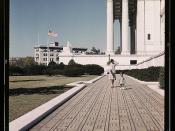Brown Vs. Board of Ed.
Linda Brown and Topeka board of education went to court in 1954 due to the discrimination against the young eight year old girl. The case took place in Topeka, Kansas where the young girl was denied admittance to a school that was much closer to her house just because she was African-American. The school board witch was composed of all white people showed that is was evident that they unlawfully denied this girl into that school based on her skin color.
Chief Justice Warren said in his own words 1)"Segregation is a denial of the equal protection of the laws."� The courts decision on the case was that of an unanimous vote witch was in Browns favor, the schools board of education was found to be wrong and discriminate. The court held 2) "segregation of white and colored children in public schools has a detrimental effect upon the colored children."�
The impact of this landmark case involving Brown and the board of education in Topeka, Kansas was that of a revolution all around the country witch also delt with similar problems and cases. Many children (more specifically black children) were admitted to the school of their choose without any flack now because of this case. The decision of the case reversed the "separate but equal"� doctrine.
Plessy Vs. Ferguson In the supreme court case Plessy versus Ferguson the two main litigants involved were the defendant Homer Adolph Plessy and Judge Ferguson. This case took place in Louisiana in the year of 1896. Returning home by rail from New Orleans to Baton Rouge, Homer Adolph Plessy was asked by railroad officials to sit in the segregated area of the train, he refused and was arrested. Plessy then petitioned the Louisiana court for a writ against Ferguson...


